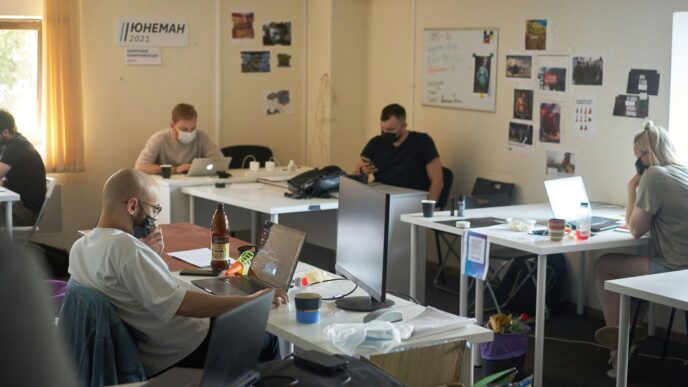Ever wonder what companies own other companies? It’s not always as straightforward as it seems. Beneath the surface of well-known brands, there can be a complex web of ownership. Sometimes this is for legitimate business reasons, like expanding into new markets or acquiring a competitor. But other times, these hidden connections can be used for less than honest purposes. Let’s pull back the curtain a bit and explore this fascinating, and sometimes murky, world of corporate ownership.
Key Takeaways
- Shadow companies are entities set up to hide the true owners or financial dealings of a business, often used in fraud.
- Companies create other companies for various reasons, including growth, but also to obscure where money comes from or goes.
- Complex structures with multiple layers of companies, often in offshore locations, make it hard to track ownership and transactions.
- These hidden structures can be exploited for illegal activities like money laundering and financial fraud.
- Understanding these hidden networks and recognizing warning signs is important for transparency and preventing financial crime.
Understanding What Companies Own Other Companies
It’s a question that pops up more often than you might think: who actually owns what? When you look at a big corporation, it’s rarely just one single entity. Instead, you often find a tangled web where companies own other companies, and those companies might own more. It’s like a set of Russian nesting dolls, but with legal documents and financial statements.
The Elusive Nature of Shadow Companies
These structures can get pretty complicated, and sometimes, intentionally so. We’re talking about entities that aren’t always easy to see or understand. They operate in the background, making it tough to figure out who’s really in charge or where the money is actually coming from. This lack of clarity is often the first sign that something might be hidden. It’s not always for bad reasons, but it certainly makes things mysterious.
Defining Shadow Companies and Their Purpose
So, what exactly is a shadow company? Think of it as a business entity that’s set up in a way that makes its operations or ownership hard to track. They might be used for legitimate reasons, like simplifying complex transactions or managing assets across different regions. For instance, a company might set up a separate entity just to hold its real estate holdings, which can make managing those properties easier. A pure holding company is a good example of this, designed solely to own other businesses.
Why Companies Own Other Companies
There are several reasons why a company would end up owning another. It could be for:
- Expansion: Buying up competitors or companies that offer complementary services.
- Asset Management: Holding specific assets like property, patents, or investments in a separate legal entity.
- Risk Management: Isolating certain business activities or liabilities within a distinct company.
- Tax Benefits: Structuring ownership to take advantage of different tax laws in various jurisdictions.
- Operational Efficiency: Creating specialized subsidiaries for different functions, like manufacturing or research.
Sometimes, these arrangements are straightforward. Other times, they form part of a much larger, more intricate network designed to obscure the ultimate control or financial flows.
How Shadow Companies Operate

So, how do these shadowy entities actually work? It’s not as simple as just drawing a name out of a hat. They’re built to be confusing, like a maze designed to keep you guessing.
First off, they need to look real. Establishing legitimate-appearing entities is the first hurdle. This means setting up a company with a proper name, maybe even an office address, that doesn’t immediately scream ‘scam’. It’s all about creating a facade. They might register these companies in places where the rules are pretty relaxed, making it harder for anyone to peek behind the curtain. Think of it like putting on a disguise – you want to blend in, not stand out.
Then comes the part where they really get clever with secrecy. Many of these operations use offshore jurisdictions. These are places that have laws designed to keep things private, often with very low taxes. It’s a big draw for people who don’t want their business known. It’s like having a secret hideout where nobody can find you. This is where you might hear about things like the shadow fleet of ships, which operate with a similar lack of transparency.
To make things even murkier, they often bring in nominee directors and shareholders. These are people who officially hold positions or own shares, but they’re just placeholders. The real power, the real money, stays hidden. It’s like having a puppet show where you only see the puppets, not the puppeteer pulling the strings. This setup makes it incredibly difficult to figure out who is actually in charge or who benefits from the company’s actions.
Here’s a quick rundown of common tactics:
- Creating Paper Companies: These are businesses that exist only in name, with no actual operations or employees. They’re perfect for moving money around without leaving a trail.
- Layering Transactions: Funds are passed through multiple accounts and companies, making it nearly impossible to trace the original source or final destination.
- Using Shell Corporations: Similar to paper companies, these are set up to be bought and sold, often to hide ownership or facilitate illegal deals.
- Exploiting Legal Loopholes: They carefully study and use the gaps in financial and corporate laws to their advantage.
Complex Ownership Structures and Their Purpose
So, why do companies go through all the trouble of setting up these intricate webs of ownership? It’s not usually for fun. Often, it’s about making things look a certain way, or sometimes, making them harder to see. Think of it like building a maze. You can get through it, sure, but it takes time and effort, and you might get lost along the way.
Layering Funds Through Multiple Entities
This is where things get really interesting, and frankly, a bit murky. Layering is basically the process of shuffling money around through a bunch of different companies. The goal? To make it super hard to figure out where the money originally came from. It’s like washing dirty clothes through several machines – by the time it comes out, it looks clean, or at least, much harder to trace back to the original stain. This is a big part of how illicit funds get disguised.
- Creating a paper trail: Each transaction between companies adds another step, another document. It’s not real business, just paper moving from one place to another.
- Using different jurisdictions: Companies might be set up in different countries, each with its own rules about financial secrecy. This adds another layer of complexity for anyone trying to follow the money.
- Timing transactions: Sometimes, the timing of these transfers is designed to make them look like normal business dealings, even when they’re anything but.
Obscuring True Ownership and Financial Transactions
At its core, a lot of this complexity is about hiding who’s really in charge and what’s really going on financially. When you have a company that owns another company, which then owns another, and so on, it becomes a real challenge to pinpoint the ultimate owner. This is especially true when offshore companies are involved, where secrecy laws are often very strict. It makes it tough for regulators, law enforcement, and even potential investors to get a clear picture of the financial health or the true intentions behind these structures.
The Role of Shell Companies in Concealment
Shell companies are the workhorses of these complex structures. They’re often just a name on paper, with no real operations or employees. Their main job is to hold assets or conduct transactions that help conceal the real activities or owners. For example, a shell company might buy a piece of real estate, or a valuable piece of art. On paper, the shell company owns it. But who actually controls the shell company? That’s the million-dollar question, and often, the answer is deliberately hard to find. This concealment is key to hiding wealth, avoiding taxes, or even facilitating illegal activities.
Misuse of Corporate Structures for Fraud
It’s pretty wild how easily companies can be used for shady stuff, right? It turns out that the whole idea of a ‘corporate veil’ – which is supposed to protect owners and directors from getting personally blamed for company problems – can actually be twisted and used by fraudsters. They set up these shadow companies, and it gets really hard to tell what’s real and what’s just for show. This makes it super easy to trick people, like investors or anyone lending money, and that can lead to some massive financial losses. Think about it, it’s like building a fake wall to hide behind while you do something wrong.
Exploiting the Corporate Veil for Illicit Schemes
So, these fraudsters, they don’t just create a company and hope for the best. They actively work to blur the lines. They make their shadow companies look like they’re doing legit business, but really, they’re just a front. This makes it tough for anyone to figure out what’s actually going on. When they misuse this corporate veil, they can lie to investors, creditors, and others, and that’s how people lose their shirts. It’s a serious problem that can bring down even big, seemingly solid companies.
Manipulating Financial Reporting and Statements
Another trick up their sleeve is messing with the numbers. Shadow companies are masters at making their financial reports look way better than they are. They might cook the books by making sales look bigger than they were, or hiding expenses. Sometimes they even hide debt. This makes the company seem healthy and attractive, even when it’s falling apart. It’s all about deception to fool people into thinking they’re investing in something solid. It’s like putting a nice coat of paint on a crumbling building.
Facilitating Money Laundering and Financial Manipulation
And then there’s the money laundering part. These shadow companies often act as a pipeline for dirty money. They move funds around through a bunch of different companies, making it almost impossible for the cops to figure out where the money came from or where it’s going. They might do fake deals or just shuffle money around to make it look clean. It’s a complex dance designed to hide illegal cash. Sometimes, they even create companies that only exist on paper – shell companies – just to help with this process. It’s a whole system built on secrecy and deception.
Famous Cases Revealing Corporate Ownership Networks

The Enron Scandal and Off-Balance-Sheet Entities
Remember Enron? That energy company that just vanished practically overnight? It’s a classic example of how complicated ownership structures can hide some pretty serious problems. Enron was really good at setting up what they called "special purpose entities," or SPEs. Think of them as little side companies. The idea wasn’t entirely bad – sometimes businesses use them for specific projects. But Enron used them to hide a ton of debt and make their profits look way bigger than they actually were. It was like having a secret room in your house full of bills you didn’t want anyone to see. This whole setup made their financial reports look fantastic, but it was all smoke and mirrors. When the truth came out in the early 2000s, the company imploded, and a lot of people lost their jobs and savings. It really showed how these hidden entities could be used to pull off massive accounting fraud.
WorldCom’s Web of Deception and Shadow Companies
Then there was WorldCom, a big telecom company. Around the same time Enron went down, WorldCom admitted to some truly staggering accounting fraud – we’re talking billions of dollars. They basically cooked the books, making up expenses and hiding others. Like Enron, they used a tangled mess of related companies and transactions to make it all look legitimate. It was a complex web designed to confuse anyone looking closely, including auditors. The goal was to make the company appear much more profitable than it was. When it all unraveled in 2002, it led to the biggest bankruptcy in U.S. history at that point. It was a wake-up call about how easily corporate structures could be manipulated.
The Panama Papers and Offshore Structures
This one is a bit different but equally eye-opening. The Panama Papers, leaked in 2016, weren’t about one company’s fraud, but a massive trove of documents from a law firm in Panama. These papers revealed how wealthy individuals and public officials around the world used offshore shell companies, often set up in tax havens, for all sorts of reasons. While not all offshore companies are used for illegal purposes, the leak showed how they can be used to hide money, avoid taxes, and sometimes, to facilitate illicit activities. It highlighted a global network of secrecy and how difficult it can be to track the real owners of assets when they’re hidden behind layers of shell corporations in different countries. It really made people think about who owns what and why they might want to keep it so private.
Safeguarding Against Hidden Corporate Ownership
It can feel like a real puzzle sometimes, trying to figure out who actually owns what in the corporate world. When companies start setting up these layers of other companies, it gets even trickier. But there are ways to be more aware and protect yourself, whether you’re an investor, a business partner, or just someone trying to understand how things work.
Recognizing Warning Signs of Shadow Entities
Spotting a company that’s not what it seems takes a bit of detective work. It’s not always obvious, but there are definitely clues. Think about it like this: if something feels off, it probably is. Paying attention to unusual complexity is often the first step.
Here are some things that might make you pause:
- Overly complicated structures: If a company has a dizzying number of subsidiaries, especially in different countries, and no clear reason for it, that’s a flag. Why so many layers?
- Lack of public information: Legitimate businesses usually have a decent amount of public information available – websites, news articles, financial reports. If a company is super secretive, with almost nothing out there, it’s worth questioning.
- Frequent changes: Constantly shifting directors, shareholders, or company addresses without a clear business explanation can be a sign that someone is trying to cover their tracks.
- Transactions that don’t make sense: If a company is making a lot of deals that seem to have no real business purpose, or if money is just moving around without any clear product or service involved, that’s a big red flag.
The Importance of Transparency and Regulation
Honestly, a lot of this comes down to how open companies are and what rules are in place. When companies have to show who’s really in charge and where the money is coming from, it makes it much harder for shady stuff to happen. It’s like turning on the lights in a dark room – you can see what’s really there.
Governments and international groups are trying to get better at this. Things like requiring companies to list their actual owners, not just the names on paper, are a big deal. It makes it tougher to hide behind a bunch of shell companies. The goal is to make the whole system more honest.
Enhancing Due Diligence in Corporate Transactions
Before you jump into any deal, especially a big one, you’ve got to do your homework. This is what they call due diligence, and it’s super important. It means digging in and making sure you know exactly who you’re dealing with and what you’re getting into.
What does that look like in practice?
- Background checks: Don’t just take a company’s word for it. Look into their history, their directors, and their past dealings. Are there any skeletons in the closet?
- Verify everything: If they say they own certain assets or have certain partnerships, try to confirm it independently. Don’t rely solely on the information they provide.
- Get professional help: If a deal looks complicated, or if you’re dealing with international entities, it’s smart to get lawyers or financial experts who know this stuff inside and out. They can spot things you might miss.
- Understand the money flow: Try to trace where the money is coming from and where it’s going. If it looks like a tangled mess with no clear purpose, be very careful.
Wrapping It Up
So, we’ve looked at how companies can own other companies, sometimes in ways that aren’t immediately obvious. It’s a big, complicated web out there. Understanding these structures is important, not just for people in business, but for all of us. It helps us see how money moves and why things happen the way they do. Keeping an eye on these connections and asking questions is how we can all help keep things fair and square.
Frequently Asked Questions
What exactly are these ‘shadow companies’ you’re talking about?
Think of shadow companies as secret businesses that hide behind legitimate-looking ones. They’re often set up to do things that aren’t quite right, like hiding money or avoiding taxes. They’re like a disguise for shady dealings in the business world.
Why would a company want to own another company in secret?
Companies might own others secretly for a few reasons. Sometimes it’s to make it harder to see where money is coming from or going. Other times, it could be to avoid paying taxes or to hide debts. It’s like having a secret room in your house where you keep things you don’t want anyone else to see.
How do these secret companies manage to stay hidden?
They use a few tricks. They might set up shop in countries where rules are loose and secrets are kept tight. They also sometimes use people whose names are on paper but aren’t the real bosses, making it tough to figure out who’s actually in charge.
Can owning companies in complicated ways be illegal?
While owning other companies is normal, doing it in a way that’s meant to trick people or hide illegal activities is definitely against the law. It’s when these complex setups are used to commit fraud, launder money, or cheat others that it becomes a serious problem.
Have there been any big scandals involving these kinds of hidden companies?
Yes, absolutely! Famous cases like Enron and WorldCom showed how companies used secret entities to hide massive debts and fake profits. More recently, the Panama Papers revealed how many people and companies used secret offshore companies for questionable reasons.
How can we protect ourselves from companies with hidden ownerships?
It’s important to be aware of the signs, like overly complicated ownerships or companies registered in secretive places. Better rules and more careful checking by businesses and governments can help uncover these hidden networks and prevent bad things from happening.














